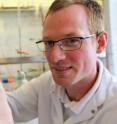Chemist solves riddle of killer diseases
Anthrax, septicemia and meningitis are some of the planet's most deadly infections. In part because doctors lack basic insights to prevent and cure diseases caused by so called Gram-positive bacteria. Now, a chemist from the University of Copenhagen has revealed the mechanism behind these deadly infections. By creating a synthetic version of a Gram-positive bacterial endotoxin, Danish synthetic chemist Christian Marcus Pedersen has made a contribution that'll compel immune biologists to revise their textbooks. More importantly, he has paved the first steps of the way towards new and effective types of antibiotics.
Chemist in international collaboration with biologists and physicians
The research results were attained in collaboration with Prof. Richard R. Schmidt of the University of Konstanz and biologists at the Leibniz-Zentrum für Medizin und Biowissenschaften in Borstel, Germany. Ulrich Zähringer, leader of the Center in Borstel, is thrilled with Pedersen's achievement.
"No one knew what substance Gram-positive bacteria released to make us sick. But because Pedersen can supply us with substances that are entirely pure, and have a known structure and composition, we are able to get a more precise answer as to why we show symptoms when these bacteria enter our body," explains Professor Zähringer.
Synthesis succeeds where biologists gave up
Lipoteichoic acid, is a substance created and present in the cell wall of Gram positive bacteria. It appears to be the culprit of stimulating immune response symptoms such as fever, inflammation and organ failure. Indeed, when exploring illness, it is critical to investigate the substances that bind themselves to healthy human cells and thus, the cell wall becomes an important place to look. But if the substance breaks down as soon as it comes under the microscope, the chances of studying its binding abilities are not very great. Therefore, it was a major breakthrough when Pedersen was able to fabricate the molecule from scratch.
"Biologists have been trying to isolate this poison from living organisms for years. But the substance has a number of active groups. That is to say, the spiked parts of the molecule which enable the entire molecule to bind to cells. This makes it extremely difficult to purify. And dirty molecules are not conducive to viable research. Therefore, it's a great advantage to fabricate the substance synthetically, because we can "build" a molecule in which everything is included... Or where we ourselves decide which part of the structure to leave out," says Christian Marcus Pedersen.
Tiresome task but outstanding results
Lipoteichoic acid consists of 335 atoms combined in tangle, the complexity of which has made it difficult to collect. To create pure and intact molecules, Pedersen needed to complete 88 so-called synthesis steps. That is to say that 88 distinct "recipes", all of which needed to function, were required in order to reach the final result. These synthetic biomolecules are a fantastic tool for biologists in the investigation of Gram-positive bacteria's attack mechanisms.
"When it comes to these bacteria, there is still no one who knows precisely what on the bacteria activates the immune system. But we can build the precise parts of the structure that we want to. And biologists can examine how what we have built reacts with the immune system," says Pedersen.
Source: University of Copenhagen
Other sources
- Chemist solves riddle of killer diseasesfrom Science DailyThu, 23 Jun 2011, 20:31:22 UTC
- Chemist solves riddle of killer diseasesfrom PhysorgThu, 23 Jun 2011, 16:02:30 UTC
